Tartaric Acid Market Size
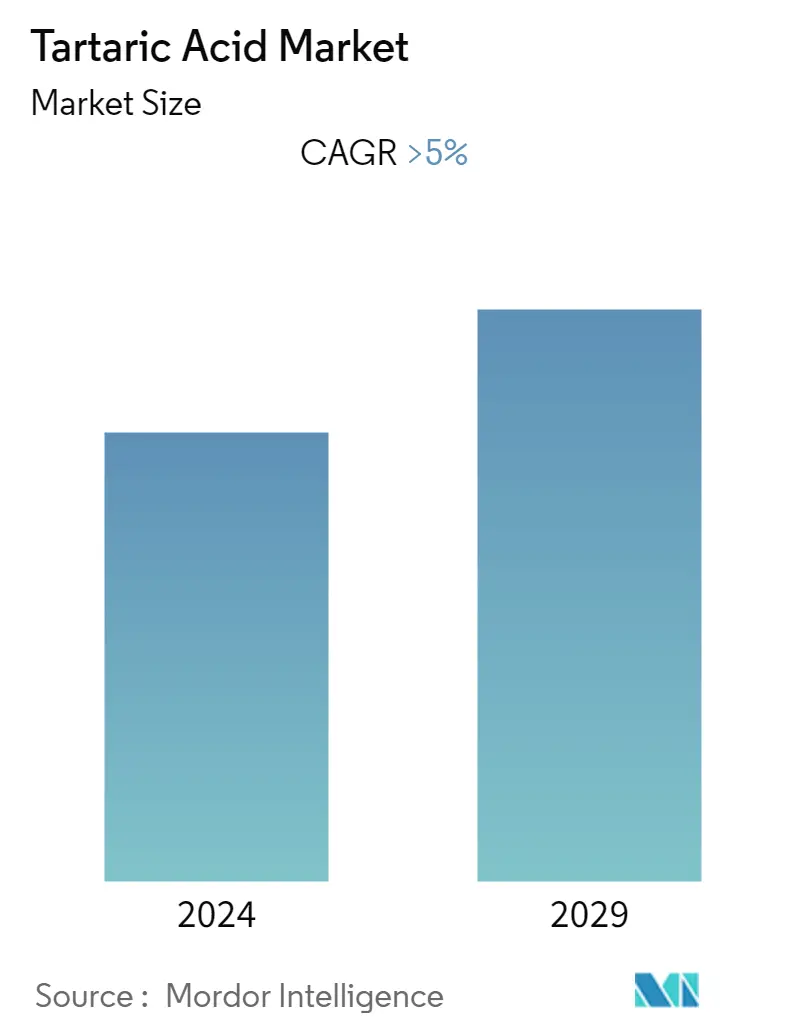
| Study Period | 2019 - 2029 |
| Base Year For Estimation | 2023 |
| CAGR | 5.00 % |
| Fastest Growing Market | Asia Pacific |
| Largest Market | Asia Pacific |
| Market Concentration | Low |
Major Players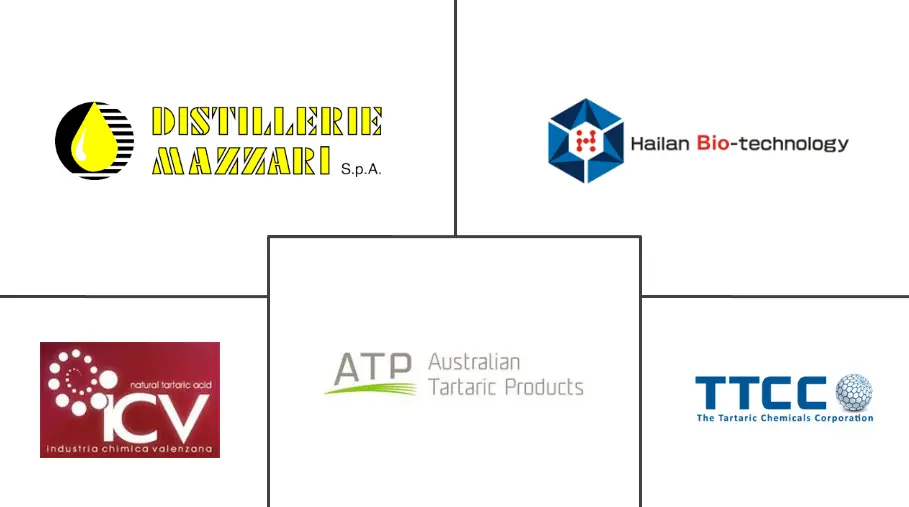
*Disclaimer: Major Players sorted in no particular order |
Tartaric Acid Market Analysis
The market for tartaric acid is projected to register a CAGR of more than 5% during the forecast period.
COVID-19 impacted various industries, affecting the tartaric acid industry growth in 2020. However, the surging construction activities post-pandemic propelled the overall industry growth.
- Over the long term, the significant factors driving the studied market growth are increased microencapsulation adoption across pharmaceuticals and food industries and rising demand from the pharmaceutical industry.
- Increasing government regulations for restricting synthetic tartaric acid use in the food industry will likely hinder the market growth.
- Adopting tartaric acid in niche applications will likely create opportunities for the market in the coming years.
- The Asia-Pacific region is expected to dominate the tartaric acid market and will likely witness the highest CAGR during the forecast period.
Tartaric Acid Market Trends
Increasing Demand from the Cosmetics Industry
- Cosmetics and personal care products include a variety of body care, as well as hair care products. Shampoos, hair conditioners, body washes, soaps, and other skincare products, occupy a significant share of the segment.
- Tartaric acid and its salts are used as pH adjusters in cosmetics and personal care products. It is considered a low-risk and safe-to-use ingredient for skincare. It is also used as an antioxidant in the production of cosmetics.
- The personal care segment accounts for the third-largest consumption share in end-user industries. Globally, this segment is growing at a moderate rate.
- An increasing consciousness catalyzed the male grooming products market growth among male consumers of personal wellness and appearance. Owing to this factor, key players are focusing on launching new and innovative products for men to increase their product offerings and customer base. It may give them an edge over their competitors.
- According to Cosmetic Europe, the personal care association, the cosmetics and personal care industry brings at least EUR 29 billion (USD 34 billion) in added value to the European economy annually. Germany is one of the biggest cosmetics markets in Europe. In 2021, the German body care and cosmetics industry generated almost EUR 790 million (USD 920 million) in revenue.
- The Asia-Pacific region accounts for over 40% of the global beauty and personal care marketplace. The production reached very high levels, thus becoming a central hub for exporting cosmetics and personal care products to developed nations, such as the United States, Canada, and Austria.
- China is the world's second-largest cosmetics market and emerging as the largest market in cosmetics and skin care products globally. The Chinese cosmetics and skin care market, which includes various industries such as makeup, skincare, hair care, and personal hygiene, experienced growth in 2021-2022. Furthermore, the continuous population growth is another factor fueling the demand for cosmetics products in the country. It, in turn, is augmenting the growth of the market studied.
- In 2022, the retail sales value of cosmetic products reached CNY 393.6 billion (USD 61 billion). As the demand for cosmetic products expands further in second-and third-tier cities of China, cosmetics retail is expected to maintain its growth momentum in the coming years.
- The tartaric acid market will likely grow during the forecast period due to all the factors above.
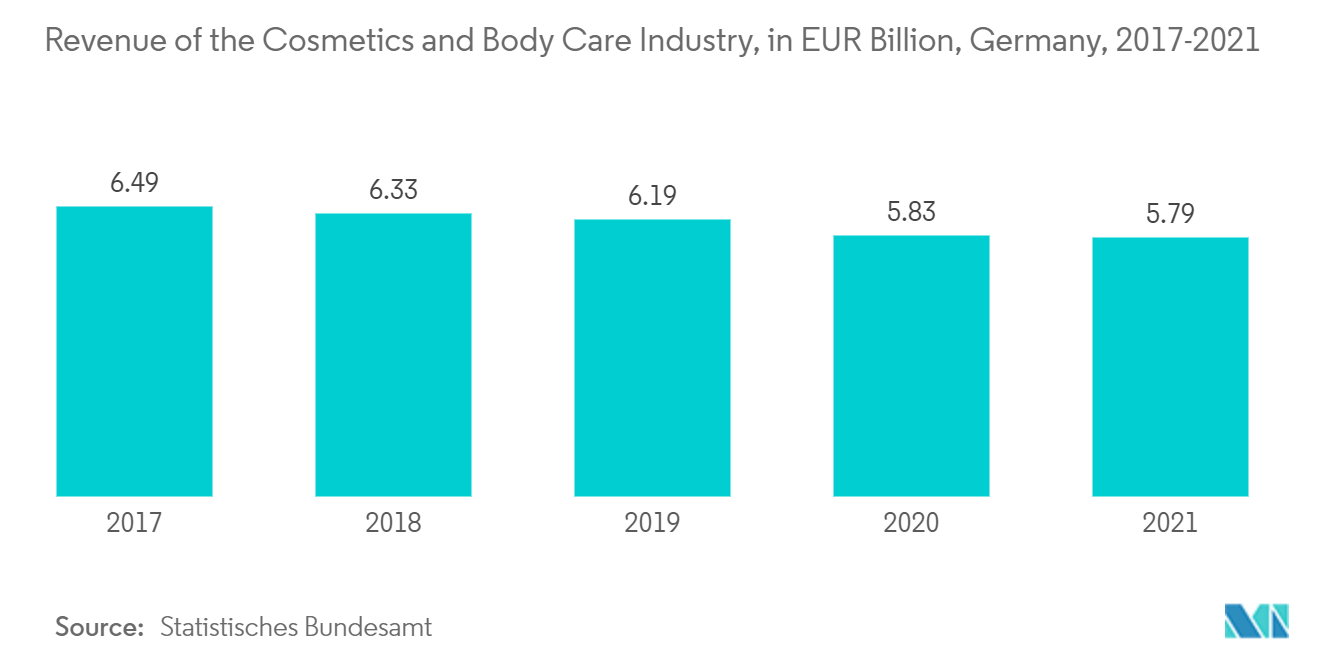
Asia-Pacific Region to Dominate the Market
- Asia-Pacific region accounted for the largest share of the tartaric acid market. Tartaric acid consumption in foods and beverages in developing markets is expected to grow, along with the increasing demand for processed food and beverages.
- The demand for tartaric acid in the region is growing significantly due to the presence of the largest consuming countries, such as China and India. The surging application of tartaric acid in the pharmaceutical industry is also one of the key factors driving the market growth.
- India holds a significant position in the global pharmaceuticals sector. India is the largest producer of generic drugs in the world. The Indian pharmaceutical industry caters to more than 50% of the global demand for various vaccines, 40% of generic medicine in the United States, and 25% of all medicines in the United Kingdom.
- Furthermore, the pharmaceutical industry in Japan is one of the largest in the world, surpassed only by the United States and China. The total production value of medical drugs in Japan amounted to approximately JPY 9.2 trillion (USD 87 billion) in 2021, a decrease from around JPY 9.3 trillion (USD 88 billion) in the previous year.
- The Asia-Pacific region includes a share of nearly 40% in the global cosmetics and growing with the increase in the awareness of personal care in the emerging economies, making it the largest market in the cosmetics and personal care industries. Cosmetics consumption is increasing among Indian teens and middle-aged people, primarily driven by an increasing focus on self-care.
- The cosmetics and personal care industry is one of India's fastest-growing consumer product markets, with a strong market entry potential for US companies. The country's personal care and cosmetics sector grew strongly, increasing shelf space in retail stores and boutiques.
- In India, the export value of cosmetics, soap, toiletries, and essential oils amounted to nearly USD 2.9 billion in 2022. It was a significant increase compared to the previous fiscal year.
- All these factors are expected to increase the market for tartaric acid in the region during the forecast period.
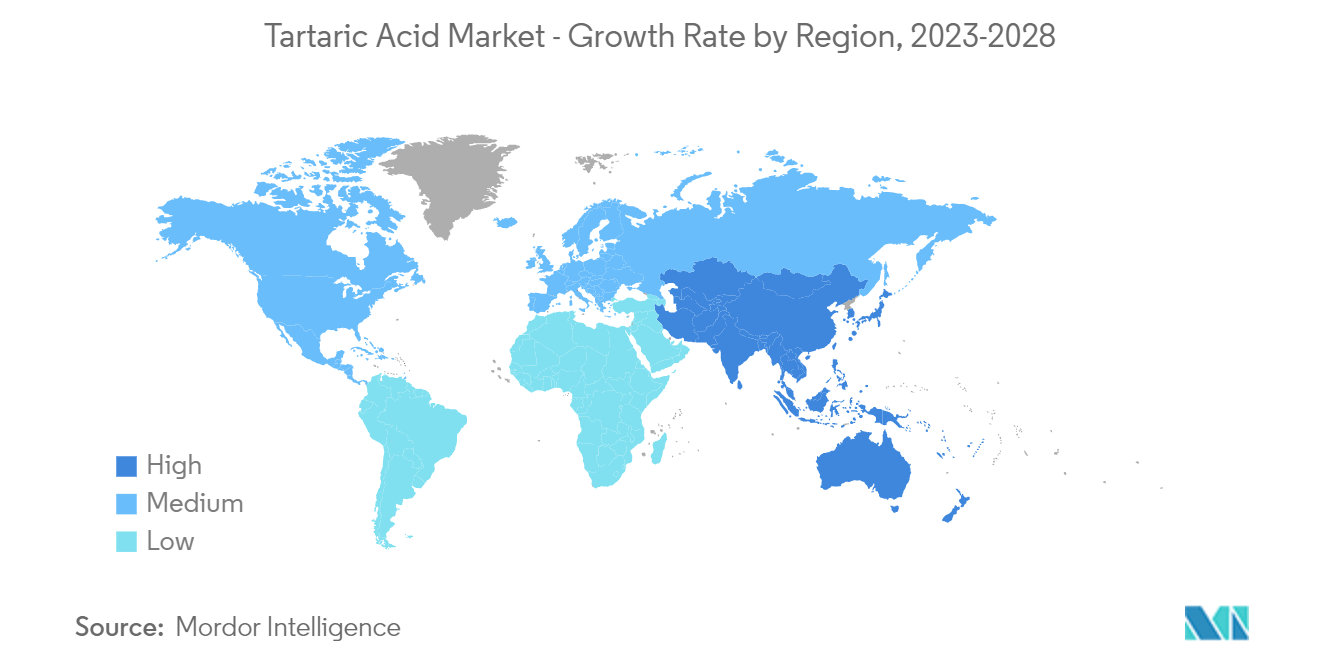
Tartaric Acid Industry Overview
The tartaric acid market is fragmented in nature. Some of the major players in the market include Distillerie Mazzari S.p.A, AUSTRALIAN TARTARIC PRODUCTS, Anhui Hailan Biotechnology Co. Ltd, The Tartaric Chemicals Corporation, and Industria Chimica Valenzana I.C.V. SpA, among others (not in any particular order).
Tartaric Acid Market Leaders
-
Anhui hailan bio-technology co., LD
-
Distillerie Mazzari S.p.A.
-
Industria Chimica Valenzana I.C.V. SpA
-
AUSTRALIAN TARTARIC PRODUCTS
-
The Tartaric Chemicals Corporation
*Disclaimer: Major Players sorted in no particular order
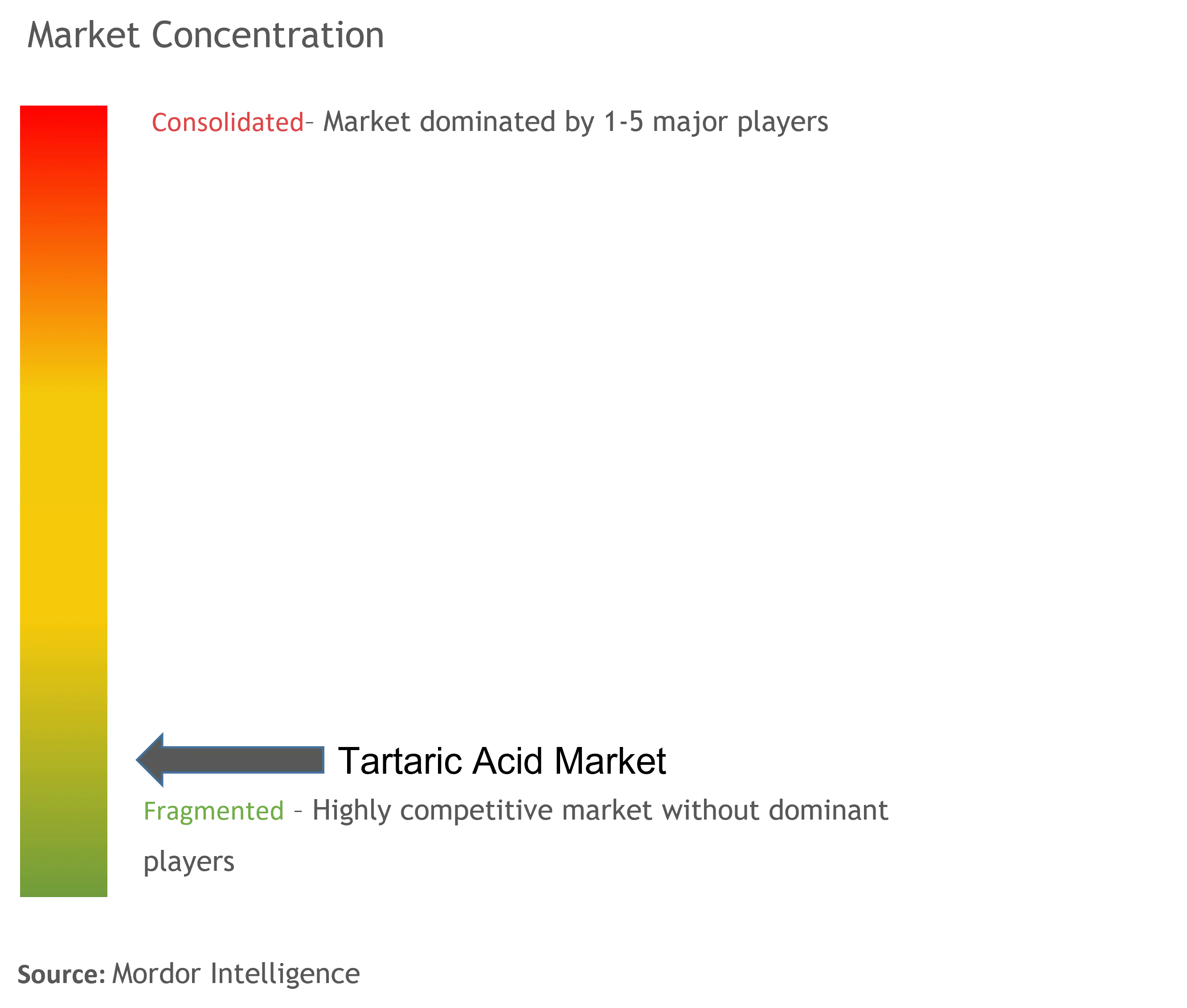
Tartaric Acid Market News
The final report will cover recent developments in the market studied.
Tartaric Acid Market Report - Table of Contents
1. INTRODUCTION
- 1.1 Study Assumptions
- 1.2 Scope of the Study
2. RESEARCH METHODOLOGY
3. EXECUTIVE SUMMARY
4. MARKET DYNAMICS
-
4.1 Drivers
- 4.1.1 Growing Demand for Wine in the Asia-Pacific and Latin American Regions
- 4.1.2 Increased Adoption of Microencapsulation across Pharmaceuticals and Food Industries
- 4.1.3 Rising Demand from the Pharmaceutical Industry
-
4.2 Restraints
- 4.2.1 Increasing Government Regulations for Restricted Use of Synthetic Tartaric Acid in the Food Industry
- 4.3 Industry Value-Chain Analysis
-
4.4 Porter's Five Forces Analysis
- 4.4.1 Bargaining Power of Suppliers
- 4.4.2 Bargaining Power of Consumers
- 4.4.3 Threat of New Entrants
- 4.4.4 Threat of Substitute Products and Services
- 4.4.5 Degree of Competition
5. MARKET SEGMENTATION (Market Size in Volume)
-
5.1 Type
- 5.1.1 Natural Tartaric Acid
- 5.1.2 Synthetic Tartaric Acid
-
5.2 Application
- 5.2.1 Preservative and Additive
- 5.2.2 Laxative
- 5.2.3 Intermediate
- 5.2.4 Other Applications
-
5.3 End-user Industry
- 5.3.1 Food and Beverage
- 5.3.2 Pharmaceutical
- 5.3.3 Cosmetics
- 5.3.4 Construction
- 5.3.5 Other End-user Industries
-
5.4 Geography
- 5.4.1 Asia-Pacific
- 5.4.1.1 China
- 5.4.1.2 India
- 5.4.1.3 Japan
- 5.4.1.4 South Korea
- 5.4.1.5 Rest of Asia-Pacific
- 5.4.2 North America
- 5.4.2.1 United States
- 5.4.2.2 Canada
- 5.4.2.3 Mexico
- 5.4.3 Europe
- 5.4.3.1 Germany
- 5.4.3.2 United Kingdom
- 5.4.3.3 France
- 5.4.3.4 Italy
- 5.4.3.5 Spain
- 5.4.3.6 Rest of Europe
- 5.4.4 South America
- 5.4.4.1 Brazil
- 5.4.4.2 Argentina
- 5.4.4.3 Rest of South America
- 5.4.5 Middle-East and Africa
- 5.4.5.1 Saudi Arabia
- 5.4.5.2 South Africa
- 5.4.5.3 Rest of Middle-East and Africa
6. COMPETITIVE LANDSCAPE
- 6.1 Mergers and Acquisitions, Joint Ventures, Collaborations, and Agreements
- 6.2 Market Share (%)**/Ranking Analysis
- 6.3 Strategies Adopted by Leading Players
-
6.4 Company Profiles
- 6.4.1 ATP Group
- 6.4.2 Anhui Hailan Bio-technology Co., ltd
- 6.4.3 AUSTRALIAN TARTARIC PRODUCTS
- 6.4.4 Changmao Biochemical Engineering Company Limited
- 6.4.5 Dastech International Inc.
- 6.4.6 Derivados Vínicos S.A.
- 6.4.7 Distillerie Mazzari S.p.A
- 6.4.8 Giovanni Randi SpA
- 6.4.9 Industria Chimica Valenzana I.C.V. SpA
- 6.4.10 Ningbo Jinzhan Biotechnology Co.,Ltd.
- 6.4.11 Omkar Speciality Chemicals Ltd
- 6.4.12 Tarac Technologies
- 6.4.13 Tártaros Gonzalo Castelló
- 6.4.14 The Tartaric Chemicals Corporation
- 6.4.15 Vinicas
- *List Not Exhaustive
7. MARKET OPPORTUNITIES AND FUTURE TRENDS
- 7.1 Adoption of Tartaric Acid in Niche Application
- 7.2 Other Opportunities
Tartaric Acid Industry Segmentation
Tartaric acid is a strong dicarboxylic acid of plant origin. It is a white, crystalline organic acid that occurs naturally in fruits such as grapes, tamarinds, citrus, etc. The tartaric acid market is segmented by type, application, and end-user industries. The market is segmented by type into natural and synthetic tartaric acid. By application, the market is segmented into preservative and additive, laxative, intermediate, and other applications. By end-user industry, the market is segmented into food and beverage, pharmaceutical, cosmetics, construction, and other end-user industries. The report also covers the market size and forecasts for the Tartaric Acid market in 16 countries across major regions. The market sizing and forecasts for each segment are based on volume (kilo tons).
| Type | Natural Tartaric Acid | |
| Synthetic Tartaric Acid | ||
| Application | Preservative and Additive | |
| Laxative | ||
| Intermediate | ||
| Other Applications | ||
| End-user Industry | Food and Beverage | |
| Pharmaceutical | ||
| Cosmetics | ||
| Construction | ||
| Other End-user Industries | ||
| Geography | Asia-Pacific | China |
| India | ||
| Japan | ||
| South Korea | ||
| Rest of Asia-Pacific | ||
| Geography | North America | United States |
| Canada | ||
| Mexico | ||
| Geography | Europe | Germany |
| United Kingdom | ||
| France | ||
| Italy | ||
| Spain | ||
| Rest of Europe | ||
| Geography | South America | Brazil |
| Argentina | ||
| Rest of South America | ||
| Geography | Middle-East and Africa | Saudi Arabia |
| South Africa | ||
| Rest of Middle-East and Africa |
Tartaric Acid Market Research FAQs
What is the current Tartaric Acid Market size?
The Tartaric Acid Market is projected to register a CAGR of greater than 5% during the forecast period (2024-2029)
Who are the key players in Tartaric Acid Market?
Anhui hailan bio-technology co., LD, Distillerie Mazzari S.p.A. , Industria Chimica Valenzana I.C.V. SpA, AUSTRALIAN TARTARIC PRODUCTS and The Tartaric Chemicals Corporation are the major companies operating in the Tartaric Acid Market.
Which is the fastest growing region in Tartaric Acid Market?
Asia Pacific is estimated to grow at the highest CAGR over the forecast period (2024-2029).
Which region has the biggest share in Tartaric Acid Market?
In 2024, the Asia Pacific accounts for the largest market share in Tartaric Acid Market.
What years does this Tartaric Acid Market cover?
The report covers the Tartaric Acid Market historical market size for years: 2019, 2020, 2021, 2022 and 2023. The report also forecasts the Tartaric Acid Market size for years: 2024, 2025, 2026, 2027, 2028 and 2029.
Tartaric Acid Industry Report
Statistics for the 2024 Tartaric Acid market share, size and revenue growth rate, created by Mordor Intelligence™ Industry Reports. Tartaric Acid analysis includes a market forecast outlook to 2029 and historical overview. Get a sample of this industry analysis as a free report PDF download.



